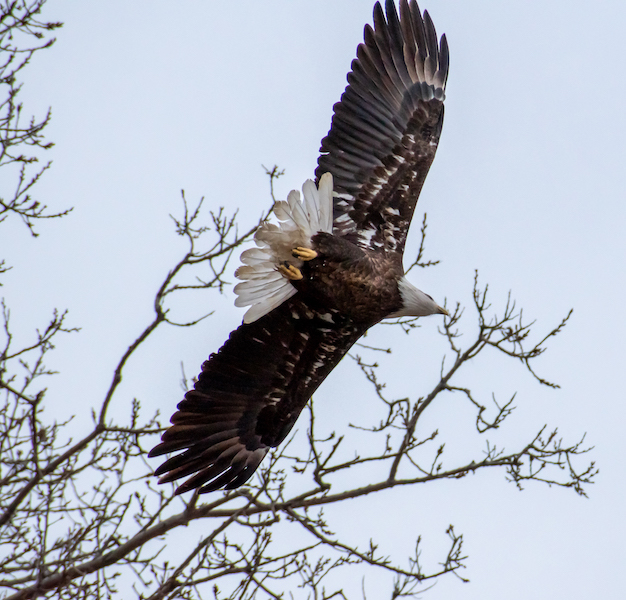Wildlife Viewing Along the Great American Rail-Trail

Beautiful scenery and connections with nature are almost guaranteed when you spend time on a trail, and the experience can be even richer when you spot local wildlife along the way. With a developing route that connects more than 145 existing rail-trails, greenways and other multiuse paths encompassing over 3,700 miles between Washington state and Washington, D.C., it’s no wonder that there are several segments of the Great American Rail-Trail® that promise idyllic wildlife-viewing opportunities. From state and national forests to wildlife preserves and wetland areas, you’re sure to be in awe of the birds, bears, deer and other animals that populate these trails. Here are a few of the route’s prime viewing spots!
Olympic Discovery Trail (Washington)

With several rainforests and shoreline locales in its midst, it’s no surprise that Washington is a treasure trove of wildlife. The 90-mile Olympic Discovery Trail is no exception, featuring tidal estuaries and waterside views. The Elwha River to La Push segment that overlooks Olympic National Park’s Lake Crescent is particularly known for its wildlife sightings. View sea lions and otters just off the trail at Ediz Hook, a sand spit that’s next to the Port Angeles City Pier. Along with the quails and bald eagles you’ll see during your trek, you can stop at the Dungeness River Nature Center adjacent to a watershed brimming with tree frogs, cougars and elk.
Related: Connections of Land, Sea and Sky: Olympic Discovery Trail
Trail of the Coeur d’Alenes (Idaho)

Spanning 73 miles, the Trail of the Coeur d’Alenes is known for its gently rolling hills, lakes and pine-dotted scenery—a landscape that many animals call home. Considered one of the best areas for birdwatching in northern Idaho, a whopping 189 bird species plus an additional 48 extremely rare species have been located here. As the Coeur d’Alene Audubon Society shares, the shores of Lake Coeur d’Alene and surrounding trailside forests provide ample opportunities to spot them. Don’t be surprised if you see sandpipers, hawks, owls and swans, along with river otters, moose, deer and muskrats.
Cowboy Recreation and Nature Trail (Nebraska)

The Cowboy Recreation and Nature Trail, one of the country’s longest rail-trails, boasts plenty of places for wildlife viewing. Featuring open prairies and grass-covered dunes, the northern Nebraska trail provides opportunities to glimpse the sandhill cranes that the state has become famous for, along with other small animals like rabbits, quails, pheasants and songbirds. Just east of Valentine, Nebraska, you can visit the nearby Fort Niobrara National Wildlife Refuge with its many bison and, throughout the Elkhorn River valley, you’ll likely view bald eagles soaring in the sky. To see smaller winged creatures, don’t miss the milkweed habitats along portions of the trail that welcome migrating monarch butterflies.
Related: Trail of the Month: Nebraska’s Cowboy Recreation and Nature Trail (Sept. 2017)
High Trestle Trail (Iowa)

Known for its iconic 130-foot-tall bridge—which offers a bird’s eye view for wildlife sightings—Iowa’s 30-mile High Trestle Trail features relics of its railroad past along with rural wildlife habitat. Every October, the trail hosts a Hawk Watch event where the public can see these majestic birds during the fall migration. Another locale near the trail that’s a hot spot for wildlife is the Des Moines River valley, specifically Swede Point Park and Ledges State Park, where you just might see barred owls, deer, foxes, raccoons, cardinals and bullfrogs.
Related: Trail of the Month: Iowa’s High Trestle Trail (July 2016)
Illinois & Michigan Canal State Trail (Illinois)

Following a historical canal in northeastern Illinois, the nearly 80-mile Illinois & Michigan Canal State Trail showcases waterside views, grassy areas and forest canopies. The McKinley Woods portion provides perhaps the best opportunities for wildlife viewing; across the river from the Des Plaines State Fish and Wildlife Area, you’ll spy herons and egrets. Several state parks along the route offer other great spots to connect with nature, including Gebhard Woods State Park, Illini State Park, Buffalo Rock State Park and Starved Rock State Park. Other not-to-miss locations include Goose Lake Prairie State Natural Area and Heidecke State Fish & Wildlife Area. Keep your eyes peeled for critters like turtles, beavers and snakes.
Cardinal Greenway (Indiana)

With a mix of suburban and rural settings, animals abound along the 62-mile Cardinal Greenway in eastern Indiana. Southeast of Muncie, two must-see stops are the Red-tail Nature Preserve, a place ospreys like to nest with its restored prairie and woodlands, and the area surrounding the Prairie Creek Reservoir, which sports a diverse collection of habitats that harbor songbirds, deer, raccoons, owls, cormorants and loons. In Muncie, connect to the White River Greenway via the Kitselman Bridge to explore the John Craddock Wetland Nature Preserve, where you’ll find frogs, waterfowl and more. On the southern end of the trail, Richmond’s Springwood Park provides access to small lakes and wooded areas ideal for birdwatching.
Related: Trail of the Month: Indiana’s Cardinal Greenway (Sept. 2018)
Ohio to Erie Trail (Ohio)

Traversing the Buckeye State, the developing 326-mile Ohio to Erie Trail, which will connect the Ohio River in Cincinnati to Lake Erie in Cleveland, doesn’t disappoint when it comes to animal sightings.
For a quick outing in nature, two short-but-sweet segments located near the middle of the route (north of Columbus) are Galena’s Hoover Scenic Trail, where deer, woodchucks and coyotes can be seen, and Sunbury’s Sandel Legacy Trail, frequented by catbirds and groundhogs. West of Dayton, look for monarch butterflies in the rural landscapes of the Prairie Grass Trail segment.
Ohio has a dozen turtle species and the reptiles can often be seen along trails, like the Heart of Ohio Trail, which traverses woodland and wetland habitat. This Metro Parks website has helpful information about what you should do if you come across one.
Related: Ohio Students Venture Into the Wild
Related: By Sight & Sound: Tips for Birding Beginners

Donate
Everyone deserves access to safe ways to walk, bike, and be active outdoors.



